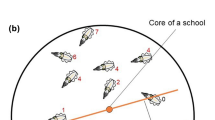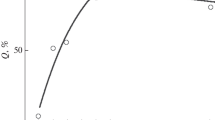Abstract
Grouping behavior has various types of antipredator functions. Some of these functions require social transmission of information, such as the many-eyes effect, whereas others do not, such as the dilution and confusion effects. Functions of grouping behavior would enhance with social transmission among group members. We investigated and compared the onsets of schooling behavior and social transmission of information in chub mackerel Scomber japonicus. Onset of schooling behavior was observed in rearing tanks by calculating the degree of parallel swimming. Onset of social transmission was examined by using visual cues from conspecifics. A group of five individuals was put in each of three experimental chambers from which they could see a group of conspecifics in the neighboring chamber. A weak electric stimulus was given to one of these chambers, and information transfer among individuals was observed. We found that social transmission by visual cues started on 30 days posthatching (25.1 mm in standard length), which was 2 weeks after the onset of schooling behavior. The late onset of social transmission relative to schooling behavior might be attributed to different predation pressure with development, or by underdevelopment of optic tectum, as the volume of the optic tectum did not increase just after the onset of schooling behavior.






Similar content being viewed by others
References
Association for the Study of Animal Behaviour (1997) Guidelines for the treatment of animals in behavioural research and teaching. Anim Behav 53:229–234
Bertram BCR (1980) Vigilance and group-size in ostriches. Anim Behav 28:278–286
Broglio C, Rodríguez F, Salas C (2003) Spatial cognition and its neural basis in teleost fishes. Fish Fish 4:247–255
Brown CR, Brown MB (1986) Ectoparasitism as a cost of coloniality in cliff swallows (Hirundo pyrrhonota). Ecology 67:1206–1218
Brown C, Laland KN (2003) Social learning in fishes: a review. Fish Fish 4:280–288
Brown C, Warburton K (1999) Social mechanisms enhance escape responses in shoals of rainbowfish, Melanotaenia duboulayi. Environ Biol Fisches 56:455–459
Calvert WH, Hedrick LE, Brower LP (1979) Mortality of the monarch butterfly (Danaus plexippus L): avian predation at five over wintering sites in Mexico. Science 204:847–851
Chivers DP, Smith RJF (1994) The role of experience and chemical alarm signalling in predator recognition in the fathead minnows (Pimephales promelas, Rafinesque). J Fish Biol 44:273–285
Côté IM, Poulin R (1995) Parasitism and group size in social animals: a meta-analysis. Behav Ecol 6:159–165
Couzin ID, Krause J, Franks NR, Levin SA (2005) Effective leadership and decision-making in animal groups on the move. Nature 433:513–516
Eaton RC, Bombardieri RA, Meyer DL (1977) The Mauthner-initiated startle response in teleost fish. J Exp Biol 66:5–81
Foster WA, Treherne JE (1981) Evidence for the dilution effect in the selfish herd from fish predation on a marine insect. Nature 293:466–467
Fuiman LA, Magurran AE (1994) Development of predator defenses in fishes. Rev Fish Biol Fish 4:145–183
Gallego A, Hearth MR (1994) The development of schooling behaviour in Atlantic herring Clupea harengus. J Fish Biol 45:569–588
Gould SJ (1977) Ontogeny and phylogeny. Harvard University Press, Cambridge
Hunter JR, Coyne KM (1982) The onset of schooling in northern anchovy larvae, Engraulis mordax. CalCOFI Rep 23:246–251
Ishizaki Y, Masudan R, Uematsu K, Shimizu K, Arimoto M, Takeuchi T (2001) The effect of dietary docosahexaenoic acid on schooling behaviour and brain development in larval yellowtail. J Fish Biol 58:1691–1703
Jeschke JM, Tollrian R (2005) Effects of predator confusion on functional responses. Oikos 111:547–555
Kohno H, Shimizu M, Nose Y (1984) Morphological aspects of the development of swimming and feeding function in larval Scomber japonicus (in Japansese). Nippon Suisan Gakkaishi 50:1125–1137
Krause J (1994) The influence of food competition and predation risk on size-assortative shoaling in juvenile chub (Leuciscus cephalus). Ethology 96:105–116
Krause J, Godin JGJ (1995) Predator preferences for attacking particular prey group sizes: consequences for predator hunting success and prey predation risk. Anim Behav 50:465–473
Krause J, Ruxton G (2002) Living in groups. Oxford University Press, Oxford
Kristensen EA, Closs GP (2004) Anti-predator response of naive and experienced common bully to chemical alarm cues. J Fish Biol 64:643–652
Lang F, Govind CK, Costello WJ, Greene SI (1977) Developmental neuroethology: changes in escape and defensive behavior during growth of the lobster. Science 197:682–684
Magurran AE, Higham A (1988) Information transfer across fish shoals under predator threat. Ethology 78:153–158
Magurran AE, Irving PW, Henderson PA (1996) Is there a fish alarm pheromone? A wild study and critique. Proc R Soc Lond B 263:1551–1556
Masuda R, Tsukamoto K (1999) School formation and concurrent developmental changes in carangid fish with reference to dietary conditions. Environ Biol Fisches 56:243–252
Milinski M (1984) A predator’s costs of overcoming the confusion-effect of swarming prey. Anim Behav 32:1157–1162
Nakayama S, Masuda R, Shoji J, Takeuchi T, Tanaka M (2003) Effect of prey items on the development of schooling behavior in chub mackerel Scomber japonicus in the laboratory. Fish Sci 69:670–676
Partridge BL, Pitcher TJ (1980) The sensory basis of fish schools: relative roles of lateral line and vision. J Comp Physiol A 135: 315–335
Potts WK (1984) The chorus-line hypothesis of manoeuvre coordination in avian flocks. Nature 309:344–345
Sakakura Y, Tsukamoto K (1997) Age composition in the schools of juvenile yellowtail, Seriola quinqueradiata, associated with drifting seaweeds in the East China Sea. Fish Sci 63:37–41
Smith RJF (1992) Alarm signals in fishes. Rev Fish Biol Fish 2:3–63
Treherne JE, Foster WA (1981) Group transmission of predator avoidance in a marine insect: the Trafalgar effect. Anim Behav 29:911–917
Vanegas H, Ito H (1983) Morphological aspects of the teleostean visual system: a review. Brains Res Rev 6:117–137
Wassersug R (1973) Aspects of social behaviour in anuran larvae. In: Vial JL (ed) Evolutionary biology of the anurans. University of Missouri Press, Columbia, pp 273–297
Watanabe T (1970) Morphology and ecology of early stages of life in Japanese common mackerel, Scomber japonicus Houttuyn, with special reference to fluctuation of population (in Japanese). Bull Tokai Reg Fish Res Lab 62:1–283
Webb PW (1980) Does schooling reduce fast-start response latencies in teleosts? Comp Biochem Physiol 65A:231–234
Acknowledgements
We sincerely thank Dr. M. Takahashi in National Research Institute of Fisheries Science for helping fish husbandry and A. Kobayashi in Kyoto University for teaching the microtome technique. We also thank Dr. L. A. Fuiman and Dr. A. F. Ojanguren of the University of Texas, Marine Science Institute for giving helpful comments and suggestions during the preparation of the manuscript. This experiment was conducted in compliance with current laws in Japan.
Author information
Authors and Affiliations
Corresponding author
Additional information
Communicated by Jens Krause
Rights and permissions
About this article
Cite this article
Nakayama, S., Masuda, R. & Tanaka, M. Onsets of schooling behavior and social transmission in chub mackerel Scomber japonicus . Behav Ecol Sociobiol 61, 1383–1390 (2007). https://doi.org/10.1007/s00265-007-0368-4
Received:
Revised:
Accepted:
Published:
Issue Date:
DOI: https://doi.org/10.1007/s00265-007-0368-4




